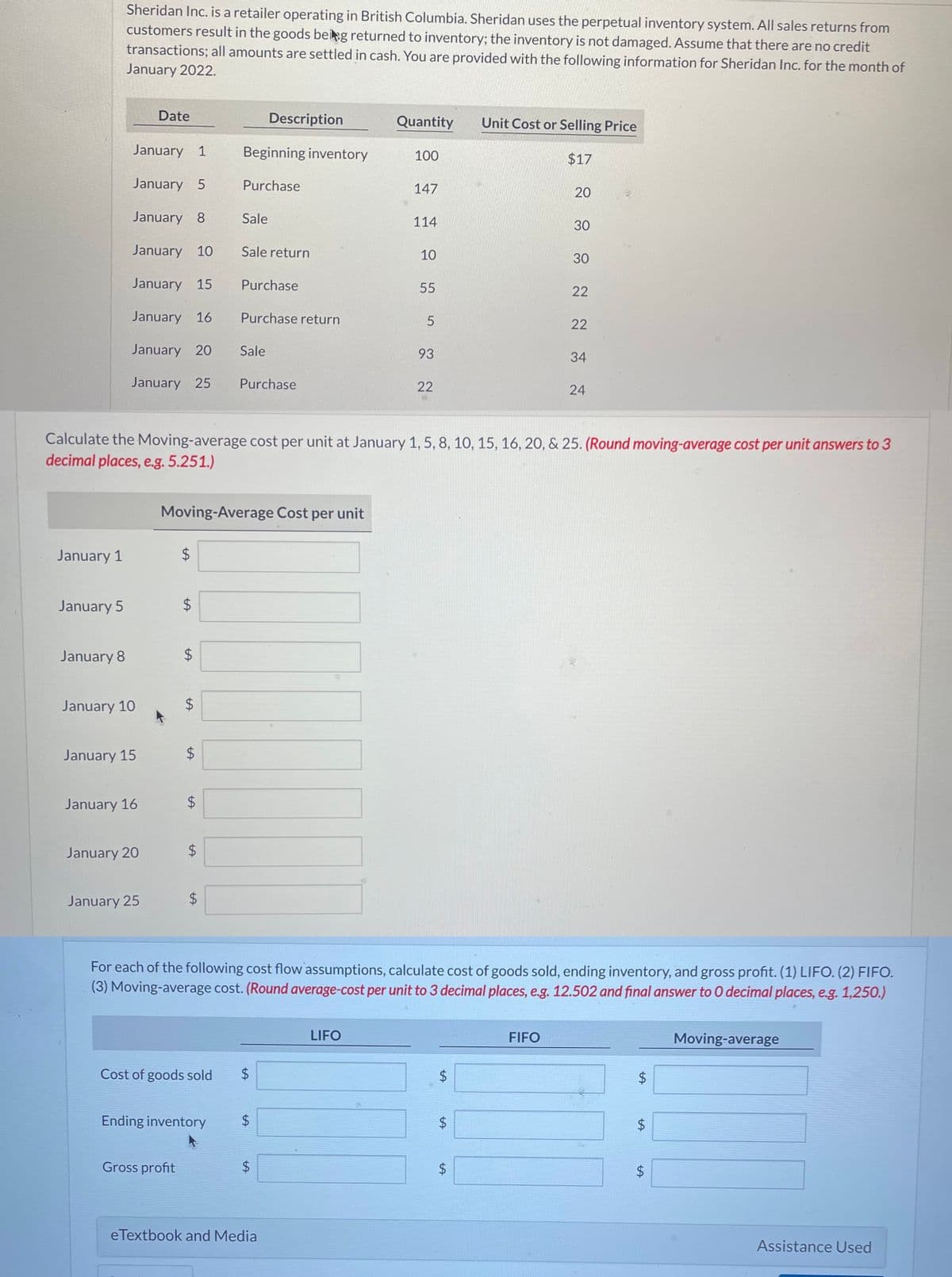January 1 January 5 Sheridan Inc. is a retailer operating in British Columbia. Sheridan uses the perpetual inventory system. All sales returns from customers result in the goods being returned to inventory; the inventory is not damaged. Assume that there are no credit transactions; all amounts are settled in cash. You are provided with the following information for Sheridan Inc. for the month of January 2022. January 8 January 1 January 5 January 8 January 10 January 15 January 16 January 20 January 25 January 10 January 15 January 16 Date January 20 January 25 4 $ $ $ Gross profit $ Moving-Average Cost per unit $ $ $ $ Beginning inventory Purchase Sale Ending inventory Sale return Purchase Purchase return Sale Description Purchase Calculate the Moving-average cost per unit at January 1, 5, 8, 10, 15, 16, 20, & 25. (Round moving-average cost per unit answers to 3 decimal places, e.g. 5.251.) Cost of goods sold $ $ $ Quantity 100 LIFO 147 114 10 55 5 93 22 $ Unit Cost or Selling Price $ For each of the following cost flow assumptions, calculate cost of goods sold, ending inventory, and gross profit. (1) LIFO. (2) FIFO. (3) Moving-average cost. (Round average-cost per unit to 3 decimal places, e.g. 12.502 and final answer to O decimal places, e.g. 1,250.) $ $17 20 FIFO 30 30 22 22 34 24 $ $ $ Moving-average
January 1 January 5 Sheridan Inc. is a retailer operating in British Columbia. Sheridan uses the perpetual inventory system. All sales returns from customers result in the goods being returned to inventory; the inventory is not damaged. Assume that there are no credit transactions; all amounts are settled in cash. You are provided with the following information for Sheridan Inc. for the month of January 2022. January 8 January 1 January 5 January 8 January 10 January 15 January 16 January 20 January 25 January 10 January 15 January 16 Date January 20 January 25 4 $ $ $ Gross profit $ Moving-Average Cost per unit $ $ $ $ Beginning inventory Purchase Sale Ending inventory Sale return Purchase Purchase return Sale Description Purchase Calculate the Moving-average cost per unit at January 1, 5, 8, 10, 15, 16, 20, & 25. (Round moving-average cost per unit answers to 3 decimal places, e.g. 5.251.) Cost of goods sold $ $ $ Quantity 100 LIFO 147 114 10 55 5 93 22 $ Unit Cost or Selling Price $ For each of the following cost flow assumptions, calculate cost of goods sold, ending inventory, and gross profit. (1) LIFO. (2) FIFO. (3) Moving-average cost. (Round average-cost per unit to 3 decimal places, e.g. 12.502 and final answer to O decimal places, e.g. 1,250.) $ $17 20 FIFO 30 30 22 22 34 24 $ $ $ Moving-average
College Accounting, Chapters 1-27 (New in Accounting from Heintz and Parry)
22nd Edition
ISBN:9781305666160
Author:James A. Heintz, Robert W. Parry
Publisher:James A. Heintz, Robert W. Parry
Chapter14: Adjustments And The Work Sheet For A Merchandising Business
Section: Chapter Questions
Problem 1SEB: ADJUSTMENT FOR MERCHANDISE INVENTORY USING T ACCOUNTS: PERIODIC INVENTORY SYSTEM Sandra Owens owns a...
Related questions
Question

Transcribed Image Text:January 1
January 5
Sheridan Inc. is a retailer operating in British Columbia. Sheridan uses the perpetual inventory system. All sales returns from
customers result in the goods being returned to inventory; the inventory is not damaged. Assume that there are no credit
transactions; all amounts are settled in cash. You are provided with the following information for Sheridan Inc. for the month of
January 2022.
January 8
January 1
January 5
January 8
January 10
January 15
January 16
January 20
January 25
January 10
January 15
January 16
Date
January 20
January 25
LA
$
$
Gross profit
LA
$
LA
Moving-Average Cost per unit
$
LA
tA
$
tA
$
Cost of goods sold
Beginning inventory
Purchase
Sale
Ending inventory
Calculate the Moving-average cost per unit at January 1, 5, 8, 10, 15, 16, 20, & 25. (Round moving-average cost per unit answers to 3
decimal places, e.g. 5.251.)
Sale return
Purchase
Purchase return
Sale
Description
Purchase
LA
LA
LA
$
eTextbook and Media
Quantity
100
LIFO
147
114
10
55
5
93
22
For each of the following cost flow assumptions, calculate cost of goods sold, ending inventory, and gross profit. (1) LIFO. (2) FIFO.
(3) Moving-average cost. (Round average-cost per unit to 3 decimal places, e.g. 12.502 and final answer to O decimal places, e.g. 1,250.)
$
LA
LA
$
Unit Cost or Selling Price
$17
$
LA
20
30
FIFO
30
22
22
34
24
LA
$
$
LA
LA
Moving-average
Assistance Used
Expert Solution
This question has been solved!
Explore an expertly crafted, step-by-step solution for a thorough understanding of key concepts.
This is a popular solution!
Trending now
This is a popular solution!
Step by step
Solved in 3 steps

Knowledge Booster
Learn more about
Need a deep-dive on the concept behind this application? Look no further. Learn more about this topic, accounting and related others by exploring similar questions and additional content below.Recommended textbooks for you

College Accounting, Chapters 1-27 (New in Account…
Accounting
ISBN:
9781305666160
Author:
James A. Heintz, Robert W. Parry
Publisher:
Cengage Learning

Century 21 Accounting Multicolumn Journal
Accounting
ISBN:
9781337679503
Author:
Gilbertson
Publisher:
Cengage


College Accounting, Chapters 1-27 (New in Account…
Accounting
ISBN:
9781305666160
Author:
James A. Heintz, Robert W. Parry
Publisher:
Cengage Learning

Century 21 Accounting Multicolumn Journal
Accounting
ISBN:
9781337679503
Author:
Gilbertson
Publisher:
Cengage


Principles of Accounting Volume 1
Accounting
ISBN:
9781947172685
Author:
OpenStax
Publisher:
OpenStax College


College Accounting (Book Only): A Career Approach
Accounting
ISBN:
9781337280570
Author:
Scott, Cathy J.
Publisher:
South-Western College Pub